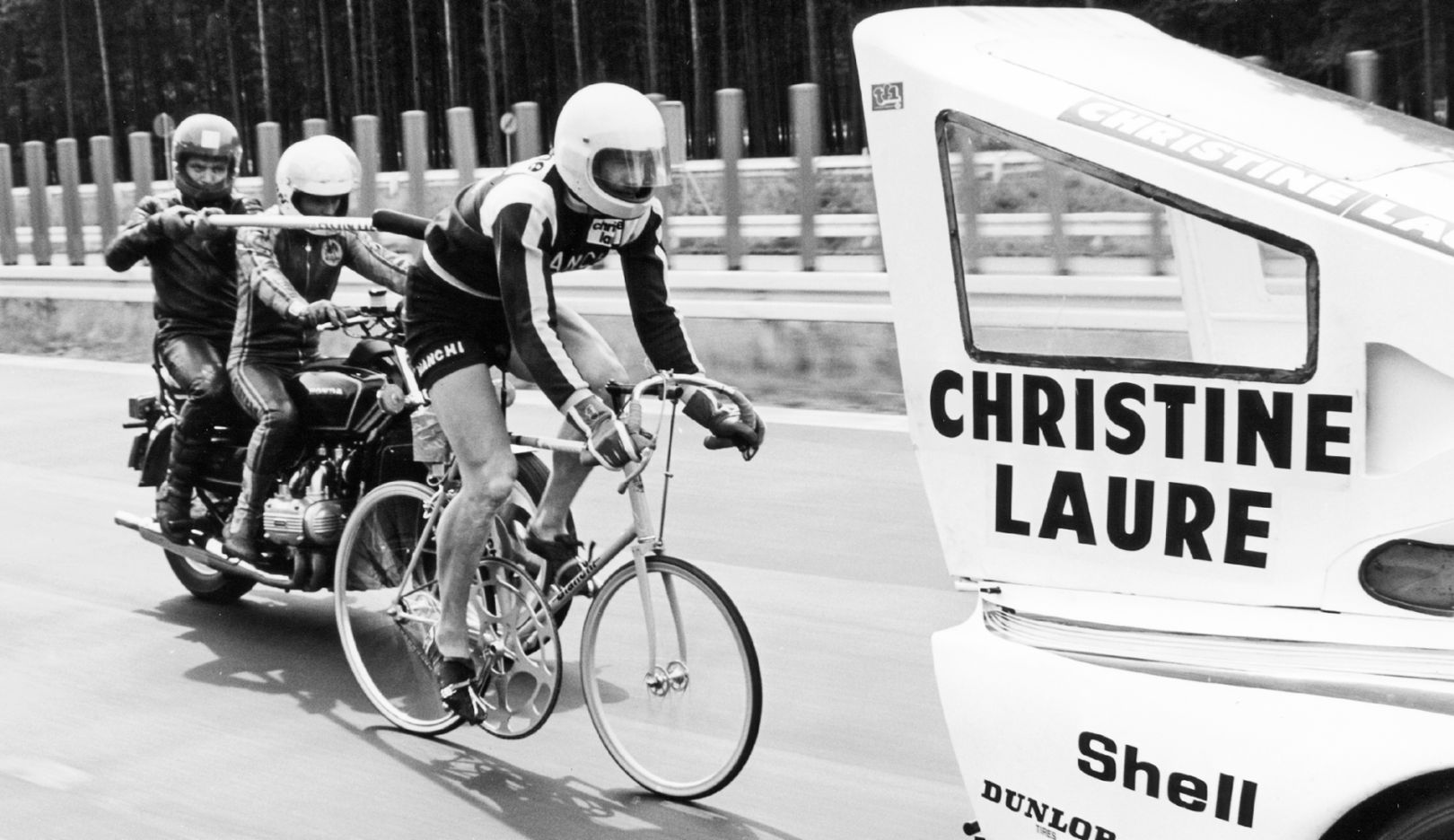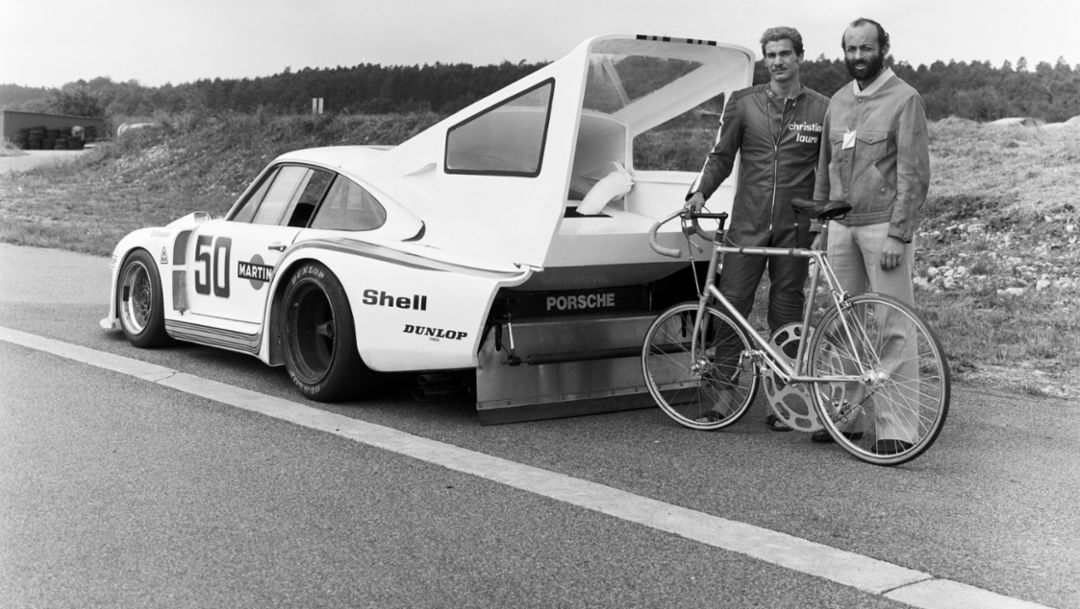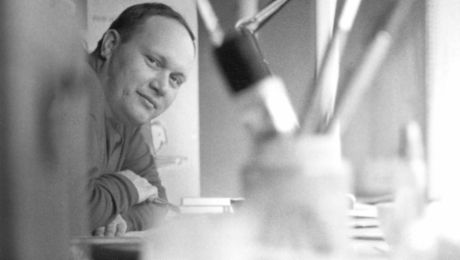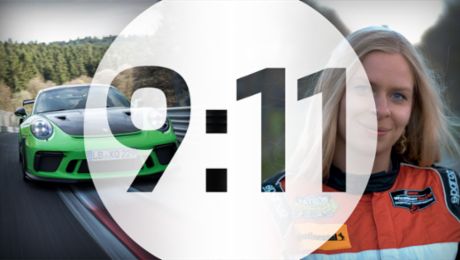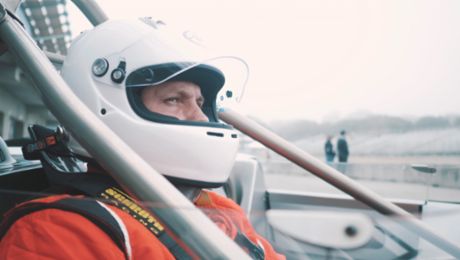The objective
To ride a bike at full speed in the slipstream of a car or motorcycle. Such was the excitement about these speed records that, at the end of the 19th century, they exercised an enormous fascination over spectators and intrepid drivers alike. After the Frenchman José Meiffret became the first person to surpass 200 kilometres per hour (204.778 km/h) in 1962 behind a Mercedes-Benz 300 SL on a German motorway, the American physician Dr. Allan Abbott, a.k.a. “The Flying Doctor”, raised the bar once again on August 25, 1973: Against the impressive backdrop of the Bonneville Salt Flats in the USA, he reached a speed of 223.466 km/h behind a 1955 Chevrolet.
In 1978, these records also fuelled the ambition of Jean-Claude Rude, a professional track cyclist at the time. The then 23-year-old had dedicated himself to achieving the tremendous speed of 240 km/h on a bicycle and all his energy into pursuing this goal.
The preparation
To this end, the head of Rude’s cycle team contacted their French compatriot Henri Pescarolo – one of the most prominent and successful racing drivers of the 1970s whose name, after 33 appearances and four victories, still evokes many memories of legendary Le Mans races. Pescarolo, who was initially sceptical of this foolhardy experimental arrangement, was eventually won over by Jean-Claude Rude’s enthusiasm.
The car and the bike
The only thing missing now was a powerful car, which is where Porsche came into play. An 800-hp 935 Turbo from the Martini Racing team, with an ingenious roof construction fitted especially for this record attempt, was exactly the right car to serve as pacemaker for the world record bid. A trapezoidal screen spanned the rear of the Porsche to ensure maximum slipstream. Even with this additional structure, the Porsche 935 had sufficient power to achieve the desired speed.
A roller along the length of the bumper allowed the front wheel of Jean-Claude Rude’s bike to effectively “stick” to the rear of the Porsche 935, making sure that he stayed right in the slipstream. The bicycle used was no ordinary model, either. The front gearwheel was almost the same circumference as the front wheel, while the rear gearwheel was only around two centimetres in diameter. With a crank revolution of around 110 centimetres, the bike had an exceptionally large gear ratio – Rude was able to cover a distance of up to 27 meters per chain ring revolution. However, this also meant that, in order to get going, the bike had to be pushed by a motorcycle with a lance, as the cyclist alone could not generate sufficient power.
The racetrack
While the previous record attempts by Meiffret and Abbott had been held on long straights (Meiffret rode on an unfinished motorway in Germany, Abbott on the Bonneville Salt Flats), Pescarolo and Rude came up against difficult conditions. Competing on a motorway, as was initially planned, was not possible.
The Volkswagen test track in Ehra-Lessien near Wolfsburg offered an alternative, but also presented additional challenges: “We realised straight away that it would be difficult”, recalls Henri Pescarolo. “There was a corner at the beginning and at the end of the straights.” Conditions that would make starting more difficult. Jean-Claude Rude had to build up speed gradually on his bike, but at the same time, the Porsche had to drive slowly enough to ensure that Rude remained in the slipstream. Not such an easy task with an 800-hp turbo engine.
This meant there was a huge amount of pressure on Henri Pescarolo behind the wheel of the Porsche. “His life was in my hands”, says the now 75-year-old, looking back. Rude had to rely on him to find the ideal starting speed, control the acceleration of the Porsche 935’s turbo and make sure that Jean-Claude Rude remained in the wind-protected zone.
The record attempt
At 10:30 am on Wednesday, August 23, 1978, the attempt gets underway. After a couple of warm-up attempts, the duo manages to get going on the straight. Jean-Claude Rude is given a push start by a motorcycle using a lance and can now begin his sprint. “He had incredible power in his legs to get the bike going and then find his rhythm. He was a professional track cyclist, he knew the effort involved, but for anyone else it would have been a superhuman feat”, says Pescarolo.
Jean-Claude Rude accelerates, pedalling fast and, as the Porsche customer magazine Christophorus reported at the time, “at a speed of 150 km/h, he exits the steep bank on the roller, now he can build up to the target speed of 240 km/h on the seven-kilometre stretch to the measuring section”. Pescarolo in the 935 is just starting to gradually build up speed, when it happens: Rude loses control of his bike. The rear tubular tyre breaks away from the rim with a jerk, becoming entangled between the wheel and the frame. The wheel locks and the rim flies across the carriageway.
Pescarolo: “We were extremely relieved that nothing happened to him”
Rude manages to regain control of the skidding bike “like a skier” and slide across the track on the rim, until he loses speed and comes to a stop after a few hundred metres, without injury.
“That was the end of the record attempt, but we were extremely relieved that nothing happened to him”, recalls Pescarolo. There would never be another attempt at the record as Jean-Claude Rude died in a tragic accident the following year.
Fred Rompelberg currently holds the absolute speed record on a bicycle
Dutchman Fred Rompelberg currently holds the absolute speed record on a bicycle. Like Allan Abbott, he attempted the record on the Bonneville Flats, and in 1995 achieved a speed of 268.8 kilometres per hour.
Nevertheless, the Porsche 935 Turbo Martini remains one of the most elegant and dynamic pace vehicles in the history of cycling records. The model – minus its rear construction – took the victory in Le Mans in 1979 and won the International Championship for Makes four times in a row.
Info
Learn more about the record attempt in Episode 7 of the 9:11 magazine.
